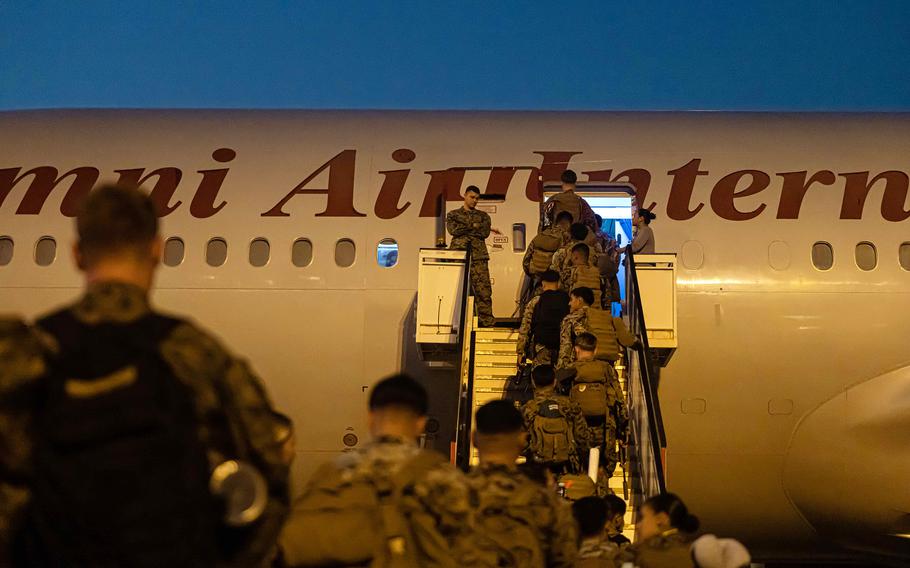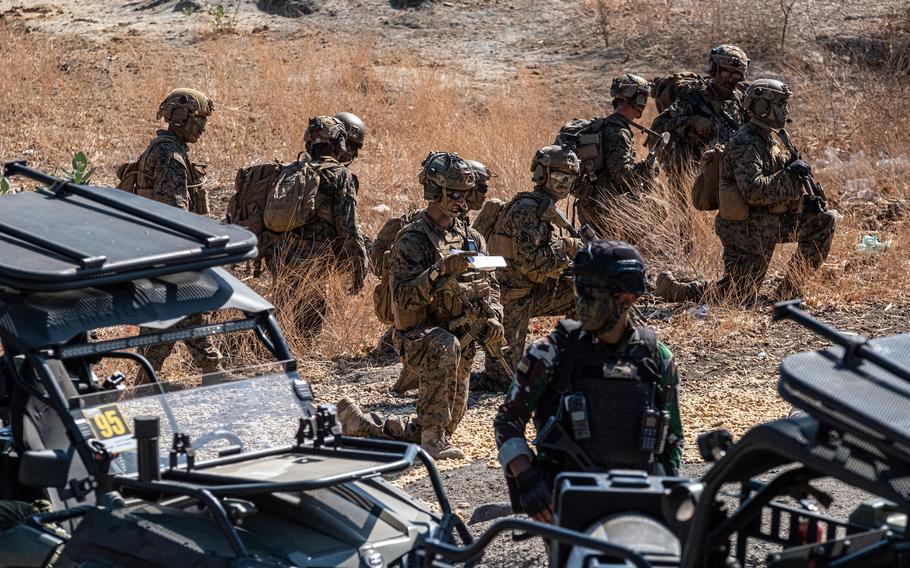
After six months Down Under, members of Marine Rotational Force - Darwin board a homebound Boeing 777 at Royal Australian Air Force Base Darwin in Australia's Northern Territory, Oct. 01, 2023. (Gabriel Antwiler/U.S. Marine Corps)
U.S. Marines deployed to Australia are back home after concluding a six-month training rotation, the Marine Corps announced Monday.
The 2023 iteration of Marine Rotational Force-Darwin — the 12th since 2012 — officially ended Oct. 1 after months of training alongside the Australian Defense Force and other allies in Australia and elsewhere, the force said in a news release.
“In six months, we completed nine major military exercises and partnered with military organizations throughout the Indo-Pacific to conduct valuable training events, all of which increased our collective readiness and posture for responding to crisis and contingency,” Col. Brendan Sullivan, force commander, said in the release.
The 2,500 Marines who comprised the rotational force began arriving in Australia in March.
The 1st Marine Regiment commands the force, which is made up of troops from the 3rd Battalion, 1st Marine Regiment and Combat Logistics Battalion 1, all from Camp Pendleton, Calif.; other components, such as Marine Medium Tiltrotor Squadron 363, contribute to the force.
In July, the Marines participated in Southern Jackaroo drills alongside the Australian army’s 7th Brigade and Japan Ground Self-Defense Force, according to the release. The force also traveled to the Philippines numerous times, including for the Australia-Philippines exercise Indo-Pacific Endeavor.
“The training opportunities provided by our Allies and partners throughout the region are unlike any other I have experienced in my career,” Sullivan said.

Members of Marine Rotational Force - Darwin train with live fire in East Java, Indonesia, during the Super Garuda Shield exercise, Sept. 11, 2023. (Skyler Harris/U.S. Marine Corps)
In July and August, the Marines participated in the largest-ever iteration of the Talisman Sabre exercise alongside thousands of other American and Australian soldiers and more than a dozen allied and partner militaries.
The force later visited Indonesia to take part in Super Garuda Shield, which ran from Aug. 31 to Sept. 13, alongside troops from Australia, Japan, Singapore, France, the United Kingdom and Indonesia itself.
This year’s deployment was marked by loss.
Less than a month after Talisman Sabre concluded on Aug. 4, three Marines attached to Marine Medium Tiltrotor Squadron 363 and deployed to the rotation force died after their MV-22B Osprey crashed on Melville Island, north of Darwin in the Northern Territory.
The three Marines were Cpl. Spencer Collart, 21, of Arlington, Va., a crew chief; Capt. Eleanor LeBeau, 29, of Belleville, Ill., a pilot; and Maj. Tobin Lewis, 37, of Jefferson, Colo., the squadron’s executive officer.
The crash marked the third fatal incident involving Marine Ospreys since March 2022.
“During the very difficult time surrounding the loss of our three beloved Marines, the Australians provided an outpouring of love and support, standing alongside us in our grieving process and assisting us in carrying on the mission,” Sullivan said.